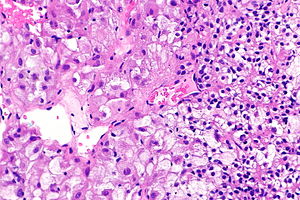TFEB-rearranged renal cell carcinoma
(Redirected from Renal tumour with t(6;11) translocation)
Jump to navigation
Jump to search
The printable version is no longer supported and may have rendering errors. Please update your browser bookmarks and please use the default browser print function instead.
| TFEB-rearranged renal cell carcinoma | |
|---|---|
| Diagnosis in short | |
 Renal cell carcinoma with morphology and IHC profile suggestive of TFEB RCC. H&E stain. | |
|
| |
| LM | solid architecture with occasional rosette-like structures; two cell populations (1) large epithelioid cells with clear to eosinophilic cytoplasm, (2) small lymphocyte-like cells |
| LM DDx | renal cell carcinoma, unclassified, angiomyolipoma (epithelioid), other renal tumours with eosinophilic cytoplasm |
| IHC | TFEB +ve (nuclear staining), HMB-45 +ve, TFE3 -ve |
| Molecular | TFEB rearrangement, t(6;11)(p21;q12) and others |
| Grossing notes | total nephrectomy for tumour grossing, partial nephrectomy grossing |
| Staging | kidney cancer staging |
| Site | kidney - see kidney tumours |
|
| |
| Clinical history | typically children or young adults |
| Prevalence | very rare ~ 2 dozen reported cases |
| Prognosis | aggressive (?) |
| Clin. DDx | other kidney tumours |
| Treatment | nephrectomy |
TFEB-rearranged renal cell carcinoma, also TFEB RCC, is a rare renal cell carcinoma recognized by the WHO classification.[1][2]
It was previously known as renal tumour with t(6;11) translocation, also t(6;11) renal cell carcinoma. It was first described in children.
It was added to WHO classification of renal neoplasia in the 2012 Vancouver modification.[3]
This entity should not be confused with ELOC-mutated renal cell carcinoma (previously known as TCEB1-mutated renal cell carcinoma).
General
- Very rare - approximately 2 dozen reported cases as of 2014.[2][4]
- Lymph node metastases are common.
- Traditionally thought of as a pediatric tumour... but cases in adults are reported.[2][5]
Microscopic
Features:[6]
- Solid with occasional rosette-like structures.
- Two cell populations:
- Large epithelioid cells with clear to eosinophilic cytoplasm.
- Small lymphocyte-like cells.
DDx:
- Renal cell carcinoma, unclassified.
- Angiomyolipoma (epithelioid).
- Clear cell renal cell carcinoma with eosinophilic cytoplasm.
- Other renal tumours with eosinophilic cytoplasm.
- Biphasic hyalinizing psammomatous renal cell carcinoma.
Images
www
IHC and morphology compatible
IHC
- TFEB +ve (nuclear staining).
- TFE3 -ve.
- Melan A +ve (13 +ve of 13 cases[9]).
- HMB-45 +ve (12 +ve of 13 cases[9]).
- PAX8 +ve/-ve (14 +ve of 23[9]).
- CAM5.2 +ve (8 +ve of 13[9]).
- RCC +ve (10 +ve of 14[9]).
- CD10 +ve (10 +ve of 14[9]).
- Cathepsin K +ve.[citation needed]
- PD-L1 +ve.[10]
Note:
- Melan A and HMB-45 are considered a good screen for this entity and recommended for renal tumour with eosinophilic cytoplasm.
Molecular
Others translocations involving TFEB have been described:[10]
- ACTB-TFEB.
- NEAT1-TFEB.
See also
- Kidney tumours.
- Renal tumour with Xp11.2 translocation.
- Chromosomal translocations.
- Pediatric pathology.
References
- ↑ Alaghehbandan R, Siadat F, Trpkov K (February 2022). "What's new in the WHO 2022 classification of kidney tumours?". Pathologica 115 (1): 8–22. doi:10.32074/1591-951X-818. PMC 10342217. PMID 36645398. https://www.ncbi.nlm.nih.gov/pmc/articles/PMC10342217/.
- ↑ 2.0 2.1 2.2 Hora, M.; Urge, T.; Trávníček, I.; Ferda, J.; Chudáček, Z.; Vaněček, T.; Michal, M.; Petersson, F. et al. (2014). "MiT translocation renal cell carcinomas: two subgroups of tumours with translocations involving 6p21 [t (6; 11)] and Xp11.2 [t (X;1 or X or 17)].". Springerplus 3: 245. doi:10.1186/2193-1801-3-245. PMID 24877033.
- ↑ Srigley, JR.; Delahunt, B.; Eble, JN.; Egevad, L.; Epstein, JI.; Grignon, D.; Hes, O.; Moch, H. et al. (Oct 2013). "The International Society of Urological Pathology (ISUP) Vancouver Classification of Renal Neoplasia.". Am J Surg Pathol 37 (10): 1469-89. doi:10.1097/PAS.0b013e318299f2d1. PMID 24025519.
- ↑ Argani, P.; Yonescu, R.; Morsberger, L.; Morris, K.; Netto, GJ.; Smith, N.; Gonzalez, N.; Illei, PB. et al. (Oct 2012). "Molecular confirmation of t(6;11)(p21;q12) renal cell carcinoma in archival paraffin-embedded material using a break-apart TFEB FISH assay expands its clinicopathologic spectrum.". Am J Surg Pathol 36 (10): 1516-26. doi:10.1097/PAS.0b013e3182613d8f. PMID 22892601.
- ↑ Ishihara, A.; Yamashita, Y.; Takamori, H.; Kuroda, N. (Sep 2011). "Renal carcinoma with (6;11)(p21;q12) translocation: Report of an adult case.". Pathol Int 61 (9): 539-45. doi:10.1111/j.1440-1827.2011.02711.x. PMID 21884304.
- ↑ Hora, M.; Hes, O.; Urge, T.; Eret, V.; Klecka, J.; Michal, M. (2009). "A distinctive translocation carcinoma of the kidney ["rosette-like forming," t(6;11), HMB45-positive renal tumor].". Int Urol Nephrol 41 (3): 553-7. doi:10.1007/s11255-008-9495-8. PMID 18998233.
- ↑ URL: http://atlasgeneticsoncology.org/Tumors/RenalCellt0611ID5011.html. Accessed on: December 29, 2014.
- ↑ Davis, IJ.; Hsi, BL.; Arroyo, JD.; Vargas, SO.; Yeh, YA.; Motyckova, G.; Valencia, P.; Perez-Atayde, AR. et al. (May 2003). "Cloning of an Alpha-TFEB fusion in renal tumors harboring the t(6;11)(p21;q13) chromosome translocation.". Proc Natl Acad Sci U S A 100 (10): 6051-6. doi:10.1073/pnas.0931430100. PMID 12719541.
- ↑ 9.0 9.1 9.2 9.3 9.4 9.5 Smith, NE.; Illei, PB.; Allaf, M.; Gonzalez, N.; Morris, K.; Hicks, J.; Demarzo, A.; Reuter, VE. et al. (May 2014). "t(6;11) renal cell carcinoma (RCC): expanded immunohistochemical profile emphasizing novel RCC markers and report of 10 new genetically confirmed cases.". Am J Surg Pathol 38 (5): 604-14. doi:10.1097/PAS.0000000000000203. PMID 24618616.
- ↑ 10.0 10.1 Caliò A, Harada S, Brunelli M, Pedron S, Segala D, Portillo SC, Magi-Galluzzi C, Netto GJ, Mackinnon AC, Martignoni G (April 2021). "TFEB rearranged renal cell carcinoma. A clinicopathologic and molecular study of 13 cases. Tumors harboring MALAT1-TFEB, ACTB-TFEB, and the novel NEAT1-TFEB translocations constantly express PDL1". Mod Pathol 34 (4): 842–850. doi:10.1038/s41379-020-00713-6. PMID 33208882.
- ↑ Online 'Mendelian Inheritance in Man' (OMIM) 607924
- ↑ Humphrey, Peter A; Dehner, Louis P; Pfeifer, John D (2008). The Washington Manual of Surgical Pathology (1st ed.). Lippincott Williams & Wilkins. pp. 281. ISBN 978-0781765275.






